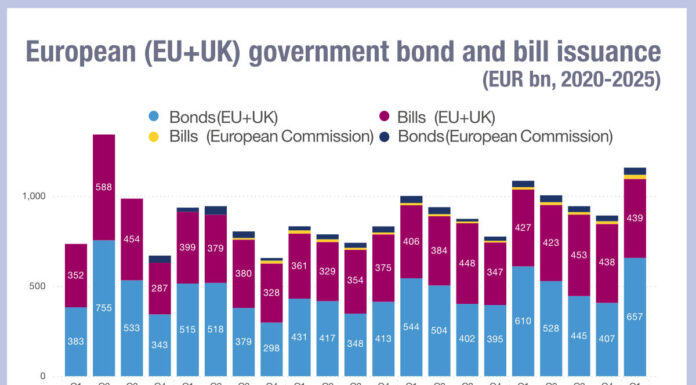Confidence in pricing data supports entirely new ways of trading through multiple trading protocols.
The DESK caught up with Matthew Walters, head of product for Portfolio Trading at MarketAxess, to discuss how this trading protocol, supported by composite+™ pricing, is giving traders the confidence to execute orders in ways that would previously have been impossible.
What does the trading desk need to consider to optimise the efficiency of portfolio trading?
Portfolio trading is a situationally efficient protocol to move large and often complicated baskets of risk. Key components are the ability to do a bidirectional portfolio trade, net spotting, and a full range of accurate, real-time pricing and analytics. It is complementary to, not a replacement for, traditional request-for-quote (RFQ), bid wanted in competition (BWIC) order types. For that reason, to use it most effectively the trading desk needs to consider and assess it as part of a full ecosystem of protocols. There will be certain lists that belong in Open Trading BWIC, while others should be a portfolio trade.
How has MarketAxess’s portfolio trading offering evolved?
We have taken the time to build an integrated solution that’s based on Composite+, our award-winning pricing & analytics engine, and normalised to our workflow for traditional lists, BWIC, offers wanted in comp (OWIC) and RFQ. A key element in the design has been optimising execution outcomes. We believe the key to success is through the informed choice of appropriate protocol.
A highly liquid list where the priority is best execution and includes high liquidity scores, execution will be achieved through traditional protocols like Open Trading. Whereas, if certainty of execution is a top priority for a list with varying liquidity profiles for its components, specifically with lower liquidity scores, portfolio trading is a really good protocol for clients to efficiently move the entire complicated basket of risk in one shot.
What are you most excited about when it comes to PT?
We have focussed on handling market structure altering trades that previously could not be done efficiently. I am talking about 500-1000+ line-item portfolio trades for multi-billion-dollar notional amounts that we have been executing over the last few months. Taken on their own, they are going to move the market and would be incredibly cumbersome if transacted on a line by line basis. Those large transactions are certainly less frequent, but they are trades that would be otherwise impossible to execute with the efficiency required. The bi-directional capabilities of our Portfolio Trading offering have also been particularly useful to clients executing swap transactions. Historically clients would only begin buying risk once they have sold enough to fund those purchases. By utilising a Portfolio Trade, they can simultaneously sell out of and buy into the ISINs of their choice.
What would have been the effect of such an order before PT?
Given the difficulties with executing such a long list on a line-by-line basis, a trader would either manage that on a spreadsheet direct to dealer, or potentially break it up between a team of traders and start chipping away on a line-by-line basis. With PT you can send it off to up to 8 dealers, look at responses in aggregate, and have a justification for best execution by virtue of getting the pricing back from most, if not all those dealers who have no issue pricing large baskets of risk. You are now transferring 1,000+ line items for several billion dollars in as little as an hour and that is altering what portfolio managers thought would be possible.
Therefore you’re making the impossible, possible! And how is MarketAxess optimising execution for such orders?
Firstly, we help route the order. We have superior analytics to our competitors and a different network i.e. we have Open Trading. Taking the wrong path to execute a trade, for example sending a list to just four counterparties when you would get 15 or 20 responses on each individual line item in Open Trading, would reduce the odds of an optimal outcome from the perspective of best-ex. We highlight those situational use cases where certainty of execution is important, or large numbers of line items, or correlation to an ETF, as use cases for portfolio trading while also ensuring our clients are not using Portfolio Trading if it puts them at a disadvantage.
How important is negotiated trading within a single portfolio trade?
It depends on the use case; clients may pre-negotiate a PT offline with a single dealer. There are also reversed collapsed portfolio trades where dealers are piping inventory in and buy-side managers are creating portfolios off of that inventory. In both those cases there would likely be some negotiation that would occur away from us as they will just use us a processing tool. The predominant use case for our platform is what we call outright portfolio trading. That could be you are selling, buying or a combination of the two and you can go out to as many as eight counterparties.
What has set the development of our protocol apart from those of our competitors has been in response to client preference, for a protocol that reduces unnecessary or unwanted negotiation from the process. The protocol requires dealers to be in by a fixed time and can only improve if the client chooses to counter. This has created a framework where dealers put their best foot forward and takes a lot of the negotiation and the countering out of the equation. To be supportive of the dealers, we make sure that we don’t release those dealer levels until all the dealers are in to ensure they are never disadvantaged by virtue of being the first to price. So, while we do allow for negotiation it is rare and allows for the efficient transfer of risk and the avoidance of multiple dealers so the client doesn’t get tied up on the back and forth. Given that PTs are executed at the aggregate, clients are increasingly relying on our analytics to compare each counterparties levels and typically will only look to ensure no component is outside of their predetermined risk tolerance for that item.
What have you done, or what can they do, to simplify the decision making around whether or not to PT, or how?
Clients can leverage our liquidity scores and our proprietary Composite+ to not only gain a liquidity profile of the basket, but also an estimation of proceeds on the basket, based on the Composite+ price. During the pre-trade phase, a lot of our users will load up a portfolio and based off our analytics start adjusting it. That can be taking out some of the less liquid items and replacing them with bonds that are a bit more liquid or based off our data, have a higher probability of being executable.
That is why I am so excited about Tradability – a new predictive and directional dataset that informs users of how many responses you would get if you were to send an individual bond into Open Trading. This will allow for a user to load up a list of 50 line items and get informed that the list has an average Tradability score of 9, with the lowest individual item coming in at 7. The user now can expect on average at least 9 responses on Open Trading with the expectation of all items receiving at least 7 responses. Now that a user is sure they will not only get certainty of execution on their list but also enough responses to justify best-ex, they would likely conclude this to be a better list for Open Trading.
In the scenario where the average Tradability score is 2 or 3, and certainty of execution is a priority, well maybe that’s a situation for a portfolio trade.
How does liquidity provision differ by geography?
We learned that in the US, dealers are far more willing to be in comp against more counterparties. We see US$500 million and up PTs go out to eight dealers and few ask the client how many they are in comp with, they just price it. In Europe the market structure differs, the dealers are more hesitant to be on the wire for any significant period of time because trades are typically executed on price not spread. There is also willingness for both the buy side and the sell side to negotiate for longer and more frequently on portfolio trades.
There are many times when portfolio trading yields best execution while ensuring certainty of execution for the entire market. Our job as a venue, is to stand between counterparties and clients to make sure that everybody has the best outcome.

©Markets Media Europe 2025

























